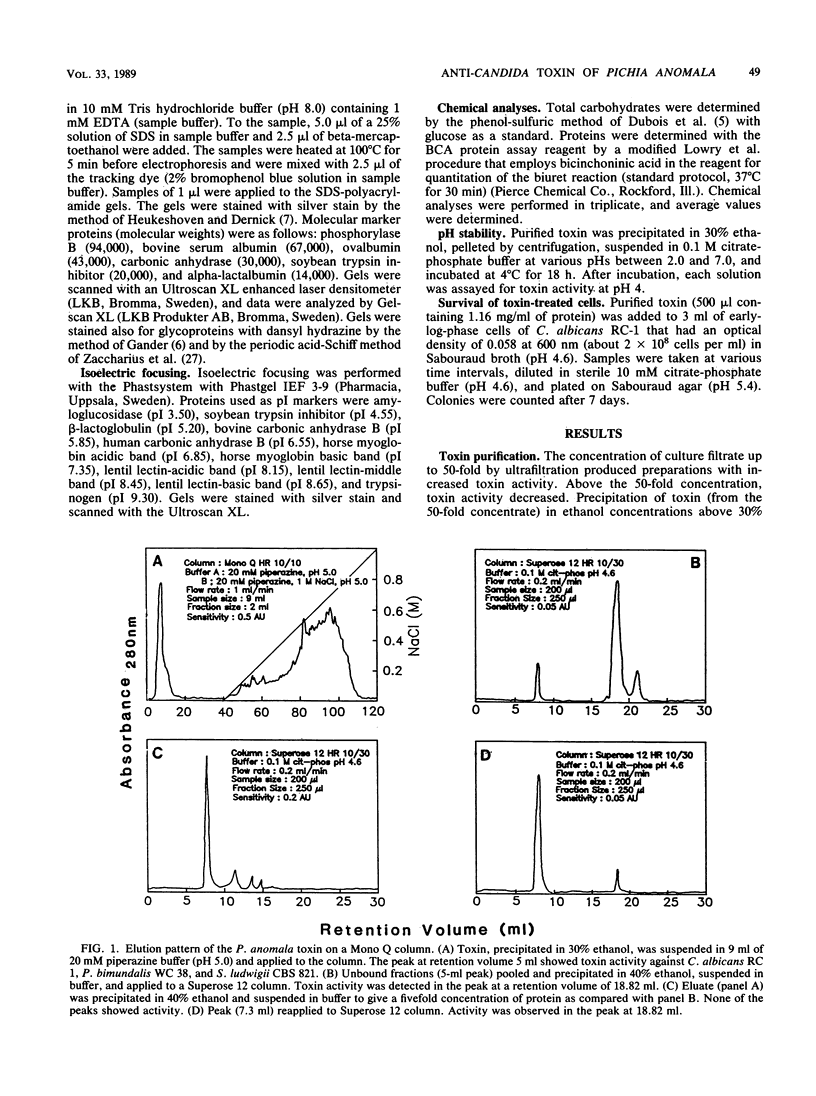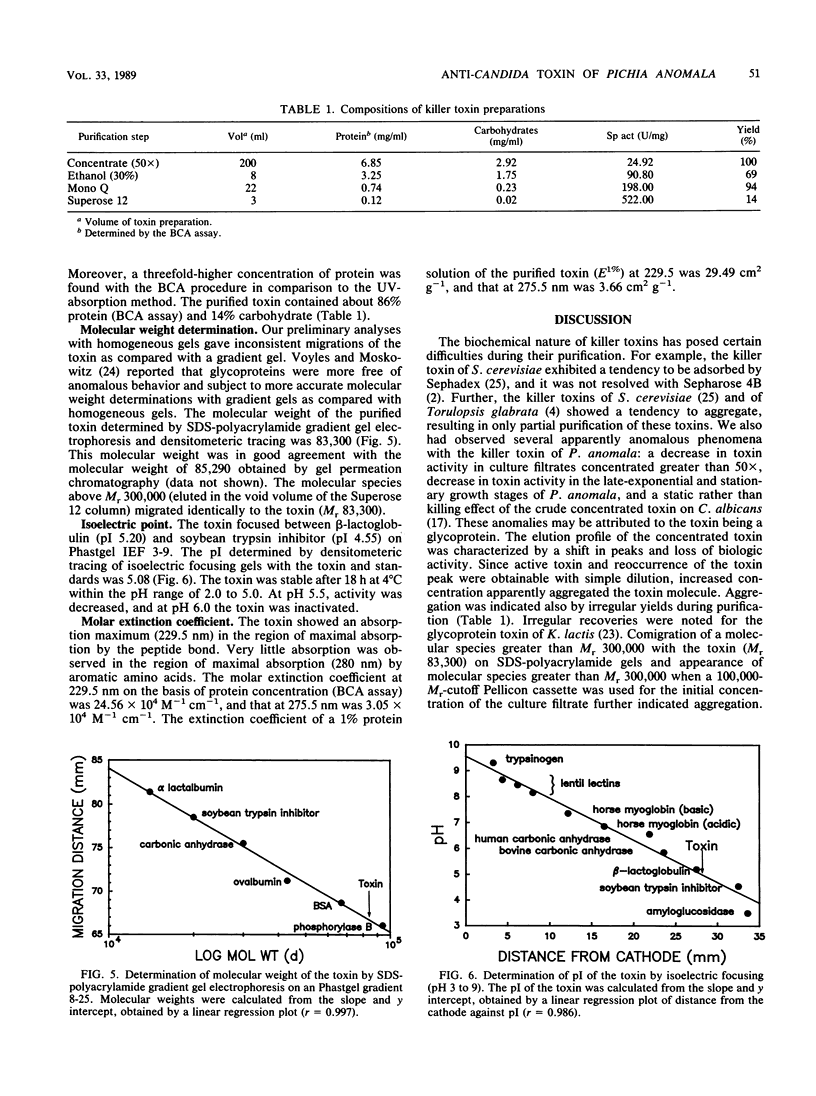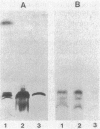Abstract
Pichia anomala WC 65 secretes a toxin that is inhibitory to a variety of yeasts, including strains of the animal pathogen Candida albicans. The toxin was purified to homogeneity by ultrafiltration, ethanol precipitation, ion-exchange chromatography with a Mono Q column, and gel permeation chromatography with a Superose 12 column. The toxin had a molecular weight of 83,300 as determined by electrophoresis on sodium dodecyl sulfate-polyacrylamide gradient gels and a molecular weight of 85,290 as determined by gel permeation chromatography. The isoelectric point of the toxin was pH 5.0. The toxin was stable between pH 2.0 and 5.0. Chemical analysis of the purified toxin indicated that the toxin was a glycoprotein composed of about 86% protein and 14% carbohydrate. At high concentrations, the toxin showed a tendency to aggregate, with loss of biological activity against C. albicans, Pichia bimundalis, and Saccharomycodes ludwigii. Purified toxin expressed killing activity against C. albicans in contrast to the static activity of the crude toxin.
Full text
PDF




Images in this article
Selected References
These references are in PubMed. This may not be the complete list of references from this article.
- Bussey H. Effects of yeast killer factor on sensitive cells. Nat New Biol. 1972 Jan 19;235(55):73–75. doi: 10.1038/newbio235073a0. [DOI] [PubMed] [Google Scholar]
- Bussey H., Saville D., Hutchins K., Palfree R. G. Binding of yeast killer toxin to a cell wall receptor on sensitive Saccharomyces cerevisiae. J Bacteriol. 1979 Dec;140(3):888–892. doi: 10.1128/jb.140.3.888-892.1979. [DOI] [PMC free article] [PubMed] [Google Scholar]
- Bussey H., Skipper N. Membrane-mediated killing of Saccharomyces cerevisiae by glycoproteins from Torulopsis glabrata. J Bacteriol. 1975 Oct;124(1):476–483. doi: 10.1128/jb.124.1.476-483.1975. [DOI] [PMC free article] [PubMed] [Google Scholar]
- Gander J. E. Gel protein stains: glycoproteins. Methods Enzymol. 1984;104:447–451. doi: 10.1016/s0076-6879(84)04112-4. [DOI] [PubMed] [Google Scholar]
- Middelbeek E. J., Hermans J. M., Stumm C. Production, purification and properties of a Pichia kluyveri killer toxin. Antonie Van Leeuwenhoek. 1979;45(3):437–450. doi: 10.1007/BF00443282. [DOI] [PubMed] [Google Scholar]
- Palfree R. G., Bussey H. Yeast killer toxin: purification and characterisation of the protein toxin from Saccharomyces cerevisiae. Eur J Biochem. 1979 Feb 1;93(3):487–493. doi: 10.1111/j.1432-1033.1979.tb12847.x. [DOI] [PubMed] [Google Scholar]
- Pfeiffer P., Radler F. Comparison of the killer toxin of several yeasts and the purification of a toxin of type K2. Arch Microbiol. 1984 Apr;137(4):357–361. doi: 10.1007/BF00410734. [DOI] [PubMed] [Google Scholar]
- Philliskirk G., Young T. W. The occurrence of killer character in yeasts of various genera. Antonie Van Leeuwenhoek. 1975;41(2):147–151. doi: 10.1007/BF02565046. [DOI] [PubMed] [Google Scholar]
- Polonelli L., Castagnola M., Rossetti D. V., Morace G. Use of killer toxins for computer-aided differentiation of Candida albicans strains. Mycopathologia. 1985 Sep;91(3):175–179. doi: 10.1007/BF00446297. [DOI] [PubMed] [Google Scholar]
- Sawant A. D., Abdelal A. T., Ahearn D. G. Anti-Candida albicans activity of Pichia anomala as determined by a growth rate reduction assay. Appl Environ Microbiol. 1988 May;54(5):1099–1103. doi: 10.1128/aem.54.5.1099-1103.1988. [DOI] [PMC free article] [PubMed] [Google Scholar]
- Schmitt M., Radler F. Molecular structure of the cell wall receptor for killer toxin KT28 in Saccharomyces cerevisiae. J Bacteriol. 1988 May;170(5):2192–2196. doi: 10.1128/jb.170.5.2192-2196.1988. [DOI] [PMC free article] [PubMed] [Google Scholar]
- Somers J. M., Bevan E. A. The inheritance of the killer character in yeast. Genet Res. 1969 Feb;13(1):71–83. doi: 10.1017/s0016672300002743. [DOI] [PubMed] [Google Scholar]
- Stark M. J., Boyd A. The killer toxin of Kluyveromyces lactis: characterization of the toxin subunits and identification of the genes which encode them. EMBO J. 1986 Aug;5(8):1995–2002. doi: 10.1002/j.1460-2075.1986.tb04455.x. [DOI] [PMC free article] [PubMed] [Google Scholar]
- Stumm C., Hermans J. M., Middelbeek E. J., Croes A. F., de Vries G. J. Killer-sensitive relationships in yeasts from natural habitats. Antonie Van Leeuwenhoek. 1977;43(2):125–128. doi: 10.1007/BF00395667. [DOI] [PubMed] [Google Scholar]
- Sugisaki Y., Gunge N., Sakaguchi K., Yamasaki M., Tamura G. Characterization of a novel killer toxin encoded by a double-stranded linear DNA plasmid of Kluyveromyces lactis. Eur J Biochem. 1984 Jun 1;141(2):241–245. doi: 10.1111/j.1432-1033.1984.tb08183.x. [DOI] [PubMed] [Google Scholar]
- Voyles B. A., Moskowitz M. Polyacrylamide gel electrophoresis of glycoproteins on single concentration and gradient gels. Biochim Biophys Acta. 1974 Jun 7;351(2):178–181. doi: 10.1016/0005-2795(74)90179-2. [DOI] [PubMed] [Google Scholar]
- Woods D. R., Bevan E. A. Studies on the nature of the killer factor produced by Saccharomyces cerevisiae. J Gen Microbiol. 1968 Apr;51(1):115–126. doi: 10.1099/00221287-51-1-115. [DOI] [PubMed] [Google Scholar]
- Zacharius R. M., Zell T. E., Morrison J. H., Woodlock J. J. Glycoprotein staining following electrophoresis on acrylamide gels. Anal Biochem. 1969 Jul;30(1):148–152. doi: 10.1016/0003-2697(69)90383-2. [DOI] [PubMed] [Google Scholar]
- Zhu H., Bussey H., Thomas D. Y., Gagnon J., Bell A. W. Determination of the carboxyl termini of the alpha and beta subunits of yeast K1 killer toxin. Requirement of a carboxypeptidase B-like activity for maturation. J Biol Chem. 1987 Aug 5;262(22):10728–10732. [PubMed] [Google Scholar]



